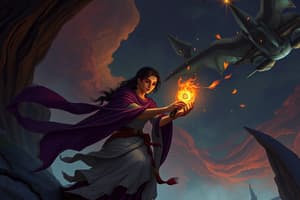Podcast
Questions and Answers
What is the primary function of conflict in a narrative?
What is the primary function of conflict in a narrative?
- To introduce unnecessary complications that distract from the main storyline
- To create tension and suspense, driving character development and plot progression (correct)
- To present a series of unrelated events that lack causality and coherence
- To provide a means for characters to easily overcome challenges without growth
How does conflict contribute to the development of well-rounded characters?
How does conflict contribute to the development of well-rounded characters?
- It highlights character flaws and motivations, allowing readers to better understand their actions (correct)
- It presents characters as one-dimensional, lacking depth and complexity
- It ensures that characters remain static and unchanging throughout the narrative
- It obscures character traits, making it difficult for readers to relate to them
What role does conflict play in maintaining a coherent narrative?
What role does conflict play in maintaining a coherent narrative?
- It establishes a cause-effect relationship between events, ensuring a consistent and coherent storyline (correct)
- It introduces random events that lack any connection to the overall plot
- It disrupts the logical flow of events, causing the narrative to become disjointed
- It eliminates the need for causality by presenting a series of unrelated occurrences
What is the importance of effective conflict resolution in a narrative?
What is the importance of effective conflict resolution in a narrative?
Which of the following is essential for developing believable and relatable conflicts?
Which of the following is essential for developing believable and relatable conflicts?
Which of the following best describes the primary function of conflict in plot development?
Which of the following best describes the primary function of conflict in plot development?
In the context of plot development, what is the primary distinction between external and internal conflicts?
In the context of plot development, what is the primary distinction between external and internal conflicts?
Which of the following best illustrates the role of conflict in promoting character growth and change?
Which of the following best illustrates the role of conflict in promoting character growth and change?
According to the provided text, which of the following examples best illustrates an external conflict in plot development?
According to the provided text, which of the following examples best illustrates an external conflict in plot development?
According to the provided text, which literary work is used as an example to illustrate internal conflict?
According to the provided text, which literary work is used as an example to illustrate internal conflict?
Flashcards are hidden until you start studying
Study Notes
Plot Development: Functions of Conflict in Text
Understanding Conflict in Plot Development
Conflict is a fundamental element of plot development. It is the spark that ignites action and propels narratives forward. As Debra Dixon notes, "conflict literally means 'to strike together'. When goals (what the characters want) and motivations (why they want it) are contested or in competition with other goals, conflict — a clashing of swords or words — results". This clash of wants and desires serves to push characters out of their comfort zones and into situations where they must face challenges and make choices, ultimately leading to growth and change.
Types of Plot Conflict
Plot conflict can take various forms. It primarily consists of external conflicts, where a character faces opposition or resistance from outside sources, such as another person, society, or nature. For instance, in William Golding's "Lord of the Flies," the boys face external conflicts in the form of nature and the harsh environment, as well as conflicts among themselves.
Internal conflicts, also known as character vs. self, arise when a character struggles with their inner demons, fears, beliefs, or desires. In Jane Austen's "Pride and Prejudice," Elizabeth Bennet faces both external conflicts with her romantic interests and internal struggles to reconcile her prideful nature with the value of love.
Role of Conflict in Plot Development
Conflict serves multiple purposes within a narrative. It creates tension and suspense by presenting obstacles that characters must overcome, ensuring that readers are invested in the outcome. Conflicts also highlight character traits, flaws, and motivations, helping to build well-rounded, relatable characters. Moreover, conflict often drives plot development through the decisions characters make in response to these challenges. For instance, Hamlet's conflict between loyalty to his father and desire for revenge leads him on a journey of self-discovery and ultimately shapes the entire play.
In addition, conflict can help in creating a sense of causality, ensuring that events unfold logically and naturally. By establishing a cause-effect relationship between events, conflict helps maintain a consistent and coherent narrative.
Creating Effective Conflict
Effective conflict requires careful planning and execution. Developing believable and relatable conflict often begins with understanding each character's individual goals and motivations. Conflicts should emerge organically from these elements, driven by character actions and resulting consequences. Furthermore, conflicts should be challenging yet realistic, allowing readers to empathize with the characters and their struggles.
Conflict resolution is equally important. While the presence of conflict keeps the story moving, resolving it in a satisfying manner brings closure and provides a sense of completion to both the characters and the reader. Ultimately, effective conflict resolution should leave the reader feeling emotionally satisfied and reflective, providing insight into the characters' growth and development throughout the narrative.
Studying That Suits You
Use AI to generate personalized quizzes and flashcards to suit your learning preferences.




